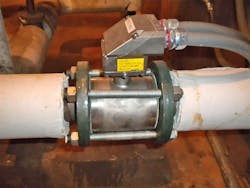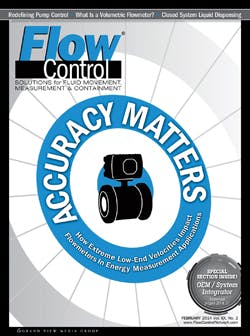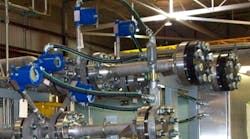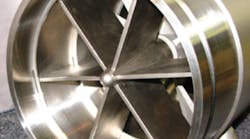In today’s business environment, we are constantly confronted with the bottom line. Energy usage has naturally become a concern, along with other overhead costs. As the emphasis on energy efficiency increases, so too does our dependence on flow measurement devices for process energy measurement.
The demand for energy conservation throughout society requires end-users and industries alike to measure energy use. For heating and chilled water applications, this requires the installation of flow and temperature measuring devices tied to a BTU computer. From this information, the end-user can assess where and how energy is being consumed, and then take steps to improve efficiency.
READ ALSO: Success at Last!—Specifying a Coriolis mass flowmeter for gas service
DOWNLOAD a PDF of this article as it appeared in Flow Control magazine:
Extreme low-end flow velocities are becoming more prominent in certain applications as a product of the drive for energy efficiency. And while such technologies as variable-frequency drives (VFDs) and modulating flow valves are enabling end-users to optimize flow in their hot/chilled water systems, do we really understand how these lower flow velocities are impacting flowmeters? Let’s consider an application (hot/chilled water) and its flow measurement components (a matched pair of temperature sensors, a flow computer, and a flowmeter). What is the single most limiting factor on the accuracy of the system?
Temperature Sensor Accuracy
Let’s consider an application with matched pair temperature sensing technology accurate to +/- 0.01 percent of span (typically 200 F) or 0.02 F. The combined accuracy of both sensors would be approximately 0.04 F. With a differential temperature of 10 F, the accuracy would be approximately +/-0.4 percent. This accuracy, even in a worst-case scenario, is better than some widely used flowmeter technologies—as you will see the paragraphs to follow. (NOTE: Temperature sensor accuracy will degrade as differential temperature is reduced.)
Flow Computer Accuracy
Today’s advanced technology allows flow computers to make calculations, provide linearization adjustments, and even further reduce temperature error by zeroing out error in the operating differential span of the application. With OIML R75 compliance, flow computers can subsequently provide reading accuracy to +/- 0.1 percent rate, making it a rather accurate component in the flowmeter application under consideration here.
Flowmeter Accuracy
Now let’s consider the flowmeter technology. Within the standard range of optimal flow velocity, you can expect the flowmeter technologies we will consider here to be accurate to +/- 0.5 percent of rate or reading. However, this specification does not reflect the range in which the meter will actually be operating in the field, or straight-run pipe requirements. To achieve +/- 0.5 percent of accuracy, most flowmeter technologies considered will require a fully developed flow profile, which usually means that they need sufficient straight-run pipe up and downstream.
In addition, the flowmeter accuracy statements are generally associated with a specific turndown value. This indicates the lowest velocity at which the meter is able to maintain its accuracy statement. For example, if a meter has a maximum velocity of 20 ft./s and performs accurately over a turndown of 10-to-1, then you can divide 20 by 10 to find that the minimum velocity at which the meter will uphold its accuracy statement is 2 ft./s. Below this minimum velocity, the flowmeters will have another accuracy specification, suggesting a fixed error that is independent of the actual flow velocity. This means that as velocity drops farther and farther below the turndown minimum, the meter becomes less accurate.
Mechanical meters using moving parts, such as turbines (typically +/- 0.5 percent of reading over a 20-to-1 turndown) and paddlewheels (typically +/- 0.75 percent of reading over a 10-to-1 turndown), will have a point at which the meter ceases to function altogether. As the moving parts foul and wear over time, this point of inoperability will occur at higher and higher velocities.
Vortex meters (typically +/- 0.8 percent of reading over a 25-to-1 turndown) will also cease to operate at low flowrates. When velocity is reduced to a point where vortices are no longer created, the meter will no longer sense flow.
Magnetic flowmeters (typically +/- 0.5 percent of reading over a 30-to-1 turndown) are much more capable of maintaining accuracy at low flow velocities, and they will even provide accurate measurements under less-than-ideal flow profile conditions. That said, most magmeters will also struggle to deliver accurate measurements at low flow velocities.
Measuring Extremely Low Flowrates
Even if you have the most accurate flowmeter on the market, does the range of flow velocities it was designed to measure align within the extended range your system is now operating in? If not, what happens below the technology’s threshold?
A flowmeter’s operating range can be put it into one of three categories, which are defined by an associated error expressed as a percentage of reading or measured value.
- Flow Measurement: The accuracy standard of flow measurement devices is +/- 5.0 percent. While we now know that the flowmeter itself is not the only factor in this error percentage, for the sake of clarity and round numbers, we’ll stick with +/- 5.0 percent.
- Flow Indication: This category encompasses flowmeters with accuracies ranging from +/- 5.0 percent to a worst case of +/- 50.0 percent. This range is admittedly vast, but the reason for detecting flow will depend on the application and the end use of the data collected.
- Flow Switch: Any error rate above +/- 50 percent will classify a device as a flow switch. Essentially, this provides an on/off indication, which in many cases is used to start/stop pumps so they don’t run dry.
Devices in all three categories can offer valid and useful information, depending on the application. However, in regards to collecting data for the purpose of determining energy usage and efficiency, it is critical to remain in the flow measurement category. That said, here we will show how some flowmeter technologies will be hard pressed to uphold +/- 5.0 percent accuracy when confronted with low flow velocities common in today’s pumped water systems.
Reducing Energy Usage in Pumped Water Systems
Prior to the use of VFDs and modulating flow valves, the majority of hot/chilled water systems operated in a pump on/off mode with parallel pumping systems used to meet the demands of the application. Concerns about excessive electricity usage were minor, so the pumps would run up their performance curves, drawing as much electrical current as they needed to meet the upstream pressure drop and maintain flow. As an initial effort to abate this, VFDs were introduced in the 1980s to bring down energy costs and provide just enough flow to satisfy downstream demand.
Subsequently, a new generation of products was created to meet the point-of-use requirements, while reducing the energy used to meet these needs. As a result, it is customary for VFDs and flow control diverting valves to be employed to optimize the electricity demand required to move water. This has, in turn, impacted the flow conditions in both new and retrofitted applications.
Before VFDs and automated diverting valves, the velocity range with pumps operating in an on/off mode was 1–15 ft./s. But today, the velocity range is 0.1-15 ft./s, or a decrease in flow velocity by a factor of 10.
So, with this extended flow range brought to light, it is important to consider how flowmeters will respond when operating at low flowrates.
Performance Concerns
To illustrate the answer to this question, we will examine three popular flowmeter technologies (dual-element turbine, dual-electrode insertion magmeters, and full-bore magmeters). These meters are compared in Figure 1, which shows the error percentage maintained between +/- 5.0 percent of rate or reading. It is interesting to see how each meter responds as we move farther down the extended velocity range in this application scenario.
As you can see, the meters increasingly lose accuracy toward the lower end of the operating range, with some struggling to provide sufficient measurements through half of the new extended operating range. While the dual-electrode insertion magmeter still has an operating accuracy specification through the extended range, its logarithmically declining accuracy makes it a flow indicator at the lower end of the new range. Even the traditional full-bore magmeter becomes a flow indicator at the lower end, making a bold statement on how difficult it can be to make an accurate flow measurement at the low-end velocities experienced when VFDs and flow control diverting valves are employed to optimize the electricity demand required to move water.
In the light of the information presented here, it is important for end-users who employ VFDs and diverting valves for hot/chilled water applications to consider how this installation will impact flowmeter performance.
Cleve Nyberg has 25 years of process control experience with a strong background in both analytical and flow instrumentation. He worked in the field as an application consultant, product sales manager, and regional sales manager for two international instrumentation companies prior to joining Cadillac Meter, also known as Central Station Steam Company. Mr. Nyberg is currently responsible for product development and technical sales for Central Station Steam Company. Mr. Nyberg can be reached at [email protected] or 503 624-6331.





